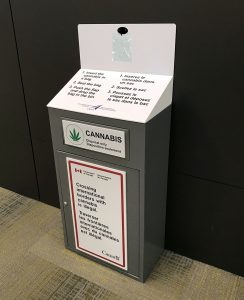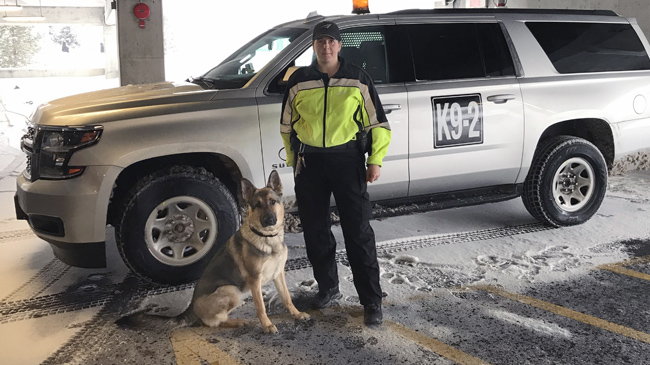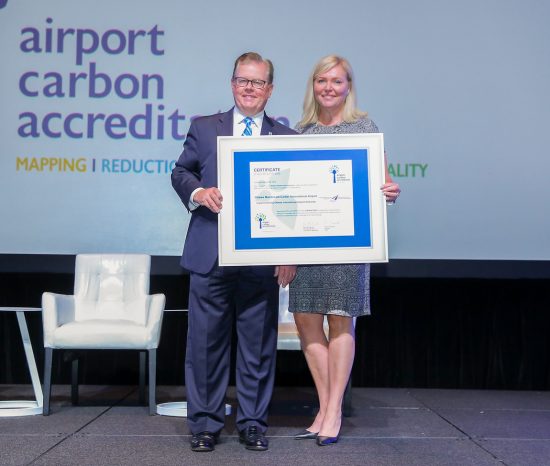2018 In Review
To Optimize Operational Performance, Ensuring Safe and Secure Operations
The safety and security of all passengers, employees, and facilities continues to be the Authority’s top priority. From security exercises to process improvements, taking a leadership role in new security domains to reducing the impact our operation has on the environment, we are tireless in our quest for innovation and best practices to ensure performance at its best. The following are vital projects we worked on in 2018 to this end.
Safety
Emergency Response Planning and Training
In 2018, Airport Emergency Response Services (ERS) responded to 19 aircraft-related incidents (in-flight and on the ground) and over 130 medical emergencies.
The ERS crews, in conjunction with the Airport Operations Coordination Centre (AOCC) and On-scene Commander (OSC) conducted 48 exercises, including two equipment deployment exercises involving airfield maintenance teams. Additionally, they worked closely with the National Research Council to complete two joint research projects related to thermal imagery and firefighting stream application.
ERS equipment improvements in 2018 include the purchase of a new Aircraft Rescue and Firefighting vehicle: a Rosenbauer Panther – 3000 gallon – 6 x 6 vehicle. We expect to take delivery of the new vehicle in 2019. In addition to the new Panther, all ERS vehicles have been equipped with a new “P-25 compliant” radio system, improving communications with first responder partners from the City of Ottawa.
Security
Annual Emergency Exercise
Exercise Integrated Response was a two-part, full deployment security exercise held in May. The Authority designed the first portion of the exercise to test the airport’s capacity to respond to a cyber attack. Authority staff quickly identified and isolated the threat, leading to a successful conclusion. The second portion of the exercise involved a vehicle-borne incident on the Departures curb, which escalated into an active shooter scenario. Members of the Ottawa Police Service, Airport Policing Section, Patrol Services, Tactical Unit, Canine, and the Explosives Disposal Units, worked with the Ottawa Paramedic Service, and the Airport Authority to address the rapidly expanding incident. More than 100 first responders, Airport Authority staff, and volunteers took part in the exercise.
OSC Training
In 2018, the Airport Authority restructured the Transport Canada-regulated position of On-Scene Controller (OSC) to allow the airport’s ERS resources to focus directly on an emergency at hand, while the OSC is now a new, separate resource. The Authority hosted more than 30 classroom and airfield training sessions with the OSC, Airport Policing Section, the Authority’s ERS, operations and airfield staff to ensure proficiency with this new concept.
Cannabis Legalization
 Legislative changes to allow the possession of cannabis in Canada came into effect in October. The possession of cannabis outside the country, however, remains illegal. To prevent our passengers from coming into conflict with the law as they travel abroad, the Authority installed cannabis amnesty bins at both of the airport’s pre-board screening checkpoints. Although rarely utilized, these bins allow passengers to dispose of their drugs safely and legally before travelling outside of Canada.
Legislative changes to allow the possession of cannabis in Canada came into effect in October. The possession of cannabis outside the country, however, remains illegal. To prevent our passengers from coming into conflict with the law as they travel abroad, the Authority installed cannabis amnesty bins at both of the airport’s pre-board screening checkpoints. Although rarely utilized, these bins allow passengers to dispose of their drugs safely and legally before travelling outside of Canada.
In addition to bin deployment, the Authority supported the federal government’s efforts to communicate the regulations and educate passengers through the deployment of regulatory signage and social media amplification.
Pass Control Office
The Pass Control Office underwent a historical change in 2018, as the longstanding contract with Commissionaires Ottawa ended in March, and the airport’s new security contractor, Paladin Security, took over the duties.
Security Operations Improvements and Enhancements
To enhance safety and security for passengers and employees, the Authority installed bollards and planters along the Arrivals and Departures roadway traffic curbs to prevent intentional vehicle ramming attacks similar to the type that was staged in Exercise Integrated Response earlier in the year. We also added emergency blue phones on each level of the Parkade increasing access to such services.
Canine Unit

Eevi and canine handler Danielle Fox
Every organization requires a comprehensive succession plan to address the needs and changes of its workforce. The Authority’s Canine Unit is no different. In 2018, the Unit welcomed three new German Shepherds Eevi, Tank, and Ares, as a succession plan to replace aging canines. The rigorous training program required to certify the dogs, which is done in conjunction with regular airport patrol duties, takes the better part of a year to complete; to date, one of the new canines is certified, while the other two continue their training regime towards certification.
The three canine teams took turns participating in various training and exercise events. These included a Canine Terrorist Explosive Scent Detection Seminar conducted at Dallas International Airport, the Canadian Police Canine Association Trials in Vancouver, British Columbia, training exercises with both Canada Border Services Agency and Via Rail canine teams, and a Homemade Explosive Detection Seminar with the Ontario Provincial Police in Kingston, Ontario. The Unit also took possession of two new fully outfitted trucks to replace their aging vehicles.
Cyber Security Leadership
NAV CANADA Cyber Summit
Ensuring the safety and security of our passengers, employees, and facilities have been key priorities of the Authority since its inception. As the threat and risk in the area of cybercrime increases in frequency, complexity, and cost to affected individuals and organizations, the Authority has embraced the need to increase its cybersecurity awareness and resilience accordingly. It has taken a leadership role among Canadian airports in several ways.
In May, the Authority played a key role in NAV CANADA’s 4th Annual Cyber Summit. Organized initially as an internal NAV CANADA discussion about the ever-changing cybersecurity landscape, the conference has evolved to include partners and stakeholders who have a shared interest in building cyber resilience.
After engaging in discussion with NAV CANADA, YOW took the lead in developing an Aviation Stream in the conference agenda that brought 15 Canadian airports to the conference for the first time. Twelve experts/speakers also participated, speaking about a variety of threats to the industry at large as well as mitigation strategies to protect and preserve system and private information. Other participants included five airlines, and representatives from Public Safety Canada and Transport Canada. This event set the stage for continued discussion and collaboration on this critically important topic. Planning is already underway for the 2019 Summit.
A-ISAC Appointment
In September, the Aviation Information Sharing and Analysis Centre (A-ISAC) appointed Mark Laroche to its Board of Directors. A-ISAC is the premier global aviation membership association that works to protect global aviation businesses, operations, and services through cyber threat intelligence and information sharing. Cyber threats know no borders, and this appointment will expand A-ISAC’s international reach into the airport sector and act as a conduit to airports and other aviation partners in Canada.
Airside
After multiple years of runway reconstruction, the Authority has shifted its focus to taxiway and apron renewal, as well as improvements to enhance the safety and efficiency of our airside facilities.
Airfield
As a part of its ongoing commitment to airside safety, the Authority completed several airside construction projects during the spring and summer. We worked with our contractors to schedule several projects in parallel to minimize operational disruptions and community impact.
The taxiway reconstruction project is part of a multi-year project to restore apron and taxiway surfaces and airside infrastructure that has reached end of life. The project scope included the reconstruction of taxiways Juliet and a section of Echo, the installation of runway pavement sensors, and the installation of a weather station system.
We installed a Simplified Short Approach Lighting System (SSALR) approach lights and towers for Runway 14 improving visibility for pilots landing on this runway. SSALR lighting is already available for runways 07, 25, and 32.
Runway 14/32 was closed May 22nd and remained so until August 22nd, moving commercial traffic to most-used Runway 07/25, although we opened it at the start of each day and again in the early evening to accommodate Air Canada’s Vancouver departures, which require the longer surface. The Authority team worked closely with its construction partners to keep the project to a very tight schedule and to mitigate any unnecessary impact on the airport campus and community at large.
Apron Renewal
The apron area north of Hangar 11 that is used for overnight aircraft parking was constructed in 1951, and was well past its end of life. In conjunction with a plan to expand north of this area, we confirmed a long-standing need to accommodate additional overnight parking, through a third-party study. The apron renewal, expansion and paving project created eight new spaces, which will allow us to adequately accommodate overnight requirements during peak periods as well as three positions for future growth.
Terminal Improvements
Moving Domestic/International Pre-board Screening
Increased demand coupled with next-generation screening processes, requires additional space at the Domestic/International pre-board screening checkpoint. The existing area will be increasingly stretched to its maximum capacity and efficiency, which prompted the Authority to explore other possibilities. After analyzing several growth scenarios, the Authority settled on the one that would provide the best return on its investment, and that complements the changes to the airport’s concession program.
The pre-board screening operation will be moved from its current location on Level 2, to an expanded area on Level 3. To accommodate this move, we are constructing a new floor over the Gate 18 area, extending from what is now the southern-most area of the Rideau Bar and Grill restaurant. Much of the existing food court area on Level 3 will be relocated to new post-security space on Level 2, however; we are keeping retail and food and beverage service available on Level 3 pre-security for passengers, visitors, and employees.
The $15 million project, which is already underway and will become more visible to passengers and visitors in the summer, will be carried out in phases to ensure uninterrupted security screening services. We will complete the entire Level 3 operation before closing the existing pre-board screening checkpoint.
Environmental Responsibility
ACI Carbon Accreditation — Level 2

Krista Kealey, VP Communications & Public Affairs, accepts Airport Carbon Accreditation Level 2 on behalf of the Airport Authority.
The Airport Authority received Level 2 Accreditation of the Airports Council International-North America (ACI-NA)’s four-level Airport Carbon Accreditation program. The program, which launched in Europe in 2009 and expanded to North America in 2014, independently assesses and recognizes airports’ efforts to manage and reduce their greenhouse gas (GHG) emissions. It certifies airports at four levels of accreditation, including mapping, reduction, optimization, and neutrality. Ottawa joins 217 Airport Carbon Accreditation-certified airports across the world, including 34 in North America.
The Authority had developed its carbon footprint mapping to obtain Level 1 Accreditation in October 2016. The Authority’s Environmental Services team then directed its efforts to achieving Level 2. To do so, they developed and implemented a GHG emission reduction target and plan. The accreditation body reviewed these in late 2017, and we received confirmation of Level 2 Accreditation on January 18th. Throughout the rest of the year, the Authority team implemented the approved GHG Management Plan, continued the reduction process, and was recertified.
Our focus in 2018 was on achieving Level 3 Accreditation. This required us to help our campus tenants find ways to reduce GHG emissions attributed to their operations. We learned early in 2019 that our efforts were successful; we expect to receive formal Accreditation for Level 3 in the Fall.
Saving Energy
The Authority undertook an extensive list of energy-saving initiatives in the terminal, roadways, parking facilities and the Hendrick Building in 2018, including:
- Modification of holding room metal halide luminaires with LED
- Modification of on-airport street lights to LED
- Modification of surface parking lots lights to LED
- Replacement of metal halide fixtures to LED – Hendrick Building
When the Authority was first accredited in 2015, YOW’s carbon footprint was 5,728 tonnes of CO2 equivalent. In 2016 and 2017, it was calculated at 5,354 tonnes and 4,987 tonnes respectively. The 2018 figure of 5,254 tonnes is higher than last year’s, but our intensity factor (emissions divided by the number of passengers divided by 1,000) of 1.013 is lower than 2017’s 1.030 and 2016’s 1.129; while our passenger number climbed by 5.6%, confirming that our collective efforts to reduce the airport’s footprint are working.
Light Rail to the Airport
As the City of Ottawa’s Light Rail Transit project progresses, and Stage 2 construction is set to begin in 2019, the Authority is preparing to fulfill its commitment to the project. Detailed plans for the airport terminal station are being finalized, and construction at the south end of Level 3 will begin by the fall of 2019.
Finance
The Financial Year at a Glance
The Canadian economy experienced growth in 2018 with key financial indicators and employment trends moving positively throughout the year despite tightening financial conditions and volatility in financial markets in the latter stages of the year. Nonetheless, this growth throughout 2018 was a backdrop for a positive impact on the results for the airport where 2018 passenger volumes again broke previous years’ records, surpassing 5.1 million passengers, an increase of 5.6% over 2017. Domestic passenger growth increased 4.9% with increased frequencies to Vancouver, Edmonton, Toronto and Fredericton. Transborder and International passenger volume grew 11.3% and 2.5%, respectively, through increased frequencies by U.S. air carriers to their hubs while increased frequencies to warm weather destinations had a positive impact on international passenger volumes.
Revenues in 2018 were 4.1% higher at $138.1 million compared to $132.6 million in 2017 due to continued strength in ground transportation and parking volumes, higher fees charged to airlines and higher passenger volumes which impacted revenues positively. As a result, the Authority finished 2018 by generating earnings before depreciation of $38.3 million compared to $32.8 million in 2017 and net earnings after depreciation of $7.0 million compared to net earnings of $3.8 million in 2017. As always, any earnings will be reinvested in airport operations and development in the interests of improved safety, efficiency, and the customer experience.
| (IN THOUSANDS OF CANADIAN DOLLARS) | 2014 $ |
2015 $ |
2016 $ |
2017 $ |
2018 $ |
|---|---|---|---|---|---|
| Revenues | 115,116 | 123,322 | 126,806 | 132,623 | 138,060 |
| Expenses before depreciation | 85,919 | 95,492 | 104,028 | 99,801 | 99,751 |
| Earnings before depreciation | 29,197 | 27,830 | 22,778 | 32,822 | 38,309 |
| Capital expenditures | 54,752 | 31,206 | 24,443 | 35,528 | 37,027 |
| AIF revenues – Gross | 46,474 | 48,384 | 49,915 | 52,244 | 54,215 |


